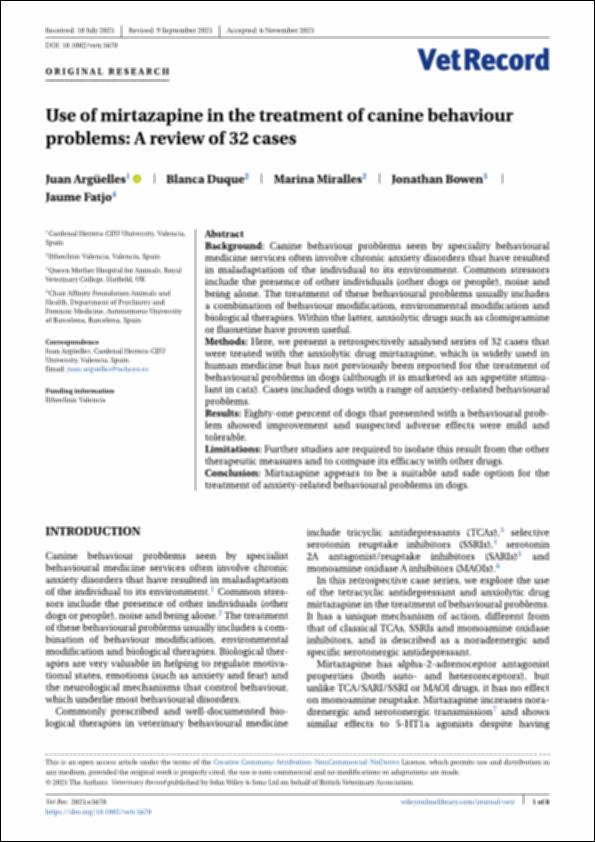Please use this identifier to cite or link to this item:
http://hdl.handle.net/10637/15520Use of mirtazapine in the treatment of canine behaviourproblems: a review of 32 cases
| Title: | Use of mirtazapine in the treatment of canine behaviourproblems: a review of 32 cases |
| Authors : | Argüelles Baquero, Juan Carlos Duque, Blanca MIralles, Marina Bowen, Jonathan Fatjó Ríos, Jaume |
| Keywords: | Perros; Dogs; Comportamiento animal; Animal behaviour; Farmacología veterinaria; Veterinary pharmacology; Mirtazapina; Mirtazapine; Medicamentos veterinarios; Veterinary drugs |
| Publisher: | John Wiley & Sons |
| Citation: | Argüelles, J., Duque, B., Miralles, M., Bowen, J. & Fatjo, J. (2023). Use of mirtazapine in the treatment of canine behaviour problems: a review of 32 cases. Veterinary Record, art. e3670. Advance online publication. DOI: https://doi.org/10.1002/vetr.3670 |
| Abstract: | Background:Canine behaviour problems seen by speciality behaviouralmedicine services often involve chronic anxiety disorders that have resultedin maladaptation of the individual to its environment. Common stressorsinclude the presence of other individuals (other dogs or people), noise andbeing alone. The treatment of these behavioural problems usually includesa combination of behaviour modification, environmental modification andbiological therapies. Within the latter, anxiolytic drugs such as clomipramineor fluoxetine have proven useful.Methods:Here, we present a retrospectively analysed series of 32 cases thatwere treated with the anxiolytic drug mirtazapine, which is widely used inhuman medicine but has not previously been reported for the treatment ofbehavioural problems in dogs (although it is marketed as an appetite stimu-lant in cats). Cases included dogs with a range of anxiety-related behaviouralproblems.Results:Eighty-one percent of dogs that presented with a behavioural prob-lem showed improvement and suspected adverse effects were mild andtolerable.Limitations:Further studies are required to isolate this result from the othertherapeutic measures and to compare its efficacy with other drugs.Conclusion:Mirtazapine appears to be a suitable and safe option for thetreatment of anxiety-related behavioural problems in dogs. |
| URI: | http://hdl.handle.net/10637/15520 |
| Rights : | http://creativecommons.org/licenses/by-nc-nd/4.0/deed.es Open Access |
| ISSN: | 0042-4900 2042-7670 (Electrónico) |
| Supported by: | Acuerdo Transformativo – 2023 |
| Issue Date: | 2023 |
| Center : | Universidad Cardenal Herrera-CEU |
| Appears in Collections: | Dpto. Medicina y Cirugía Animal |
Items in DSpace are protected by copyright, with all rights reserved, unless otherwise indicated.


